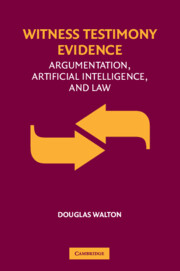Book contents
- Frontmatter
- Contents
- List of Figures and Tables
- Acknowledgments
- Introduction
- 1 Witness Testimony as Argumentation
- 2 Plausible Reasoning in Legal Argumentation
- 3 Scripts, Stories, and Anchored Narratives
- 4 Computational Dialectics
- 5 Witness Examination as Peirastic Dialogue
- 6 Applying Dialectical Models to the Trial
- 7 Supporting and Attacking Witness Testimony
- Bibliography
- Index
2 - Plausible Reasoning in Legal Argumentation
Published online by Cambridge University Press: 03 February 2010
- Frontmatter
- Contents
- List of Figures and Tables
- Acknowledgments
- Introduction
- 1 Witness Testimony as Argumentation
- 2 Plausible Reasoning in Legal Argumentation
- 3 Scripts, Stories, and Anchored Narratives
- 4 Computational Dialectics
- 5 Witness Examination as Peirastic Dialogue
- 6 Applying Dialectical Models to the Trial
- 7 Supporting and Attacking Witness Testimony
- Bibliography
- Index
Summary
A plausibilistic argument is one that yields a conclusion that is an assumption that seems to be true, on the basis of the evidence at some point in a proceeding, but may be subject to retraction if new information comes into the case at a later point in the proceeding. The conclusion is drawn tentatively, and is subject to retraction if, as a story continues to unfold, new evidence comes in showing that it is not (likely) true. Plausibility has often been mistrusted, to some extent justifiably, because it is not only subject to defeat in some cases, but in other cases, it can be misleading, and even be the basis of fallacies, of the kind long studied in logic (Walton, 1995). And yet it is becoming more and more evident through recent work in AI that the majority of arguments we are familiar with, both in legal argumentation and in everyday conversational argumentation, are based on plausible reasoning of a kind that is weaker than deductive or inductive reasoning. It is often thought to be based on abductive inference, or inference to the best explanation. MacCrimmon (2001, p. 1455) cited the evidentiary rule that a person found in possession of a recently stolen item is the thief. On an abductive model, the inference is reasonable if the person's having stolen the item is the best explanation of how he came to possess it.
- Type
- Chapter
- Information
- Witness Testimony EvidenceArgumentation and the Law, pp. 62 - 104Publisher: Cambridge University PressPrint publication year: 2007



